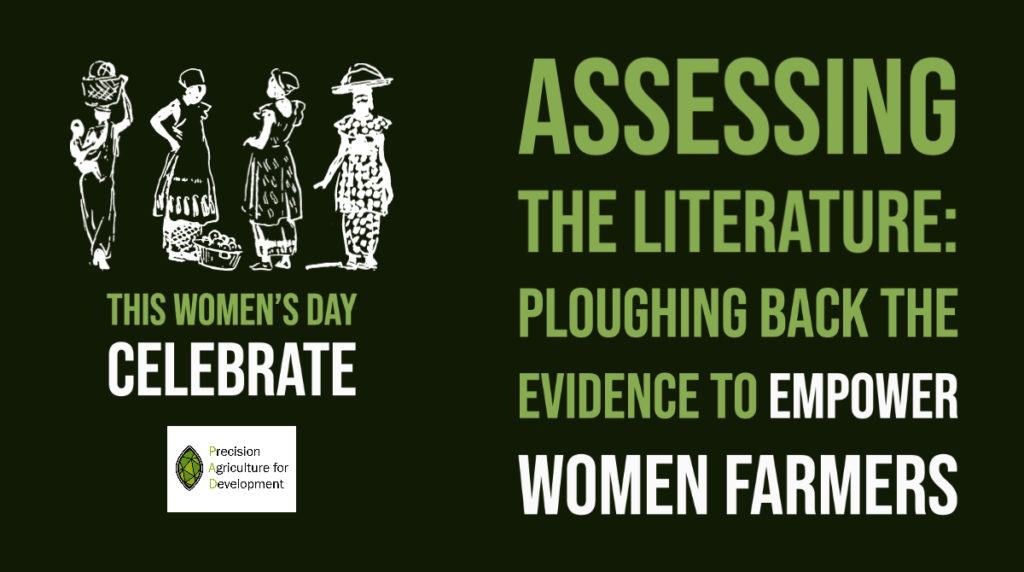Theresa Solenski, PAD Global Research and Program Associate, reflects on the growing body of gender-focused evidence – generated by the field at large, and by colleagues at PAD – we can exercise to inform evidence-based interventions to improve the lives of women.

As we mark International Women’s Day, this blog post will reflect upon and celebrate the growing evidence-base of gender-focused research that is intended to inform evidence-based policies and laws to improve the lives of women. Experimental interventions and gender-focused surveys help to illuminate the unique barriers women face as women and reveal which solutions are most impactful for empowering women and reducing poverty. These interventions and their learnings provide a foundation for future policy work wherein positive impacts are replicated and iterated to benefit women in other contexts.
Much research has already been done at the intersection of gender and agriculture in developing countries, some by my colleagues and collaborators at Precision Agriculture for Development. Researchers know that women farmers confront various constraints (for example, constrained access to land, inputs,and finances) that are significantly different and usually more onerous than those faced by their male counterparts. Addressing these constraints can unleash significant agricultural productivity, to the benefit of households and communities more generally. For example, researchers know that women under-invest in plots when their land rights are not secure. In a study of a land tenure regularization program in Rwanda, investments in soil and water conservation (which are critical given the intensive use of land in Rwanda) increased by approximately 10 percentage points for male-headed households, but for female-headed households, these investments increased by almost twice as much (Ali et. al., 2014). One policy implication we can draw from this research is that strengthening women’s land rights can lead to larger per plot investments.
We also know that there is significant evidence that women face labor constraints when it comes to their agricultural productivity. Contributing factors include cultural norms which dictate that women should tend to children and the home, and constraints on women’s access to finances to hire labor or access labor-saving technologies (such as machines or animals). These types of gendered labor constraints can impact policy to the extent that some well-intentioned gender-sensitive interventions have had the negative effect of increasing women’s time poverty (Quisumbing & Pandolfelli, 2010). Taking these considerations into account, female-targeted interventions will be most productive when they focus on high impact behaviors and practices – those that produce significant gains in productivity with little or no increase in labor intensity.
Other research has focused on complicated intra-household dynamics that play a role in the empowerment and wellbeing of females in male-headed households. In particular, while women play a significant and active role in agricultural production, data reveals that they exercise decision-making authority on fewer activities than male-heads of household. An example is that husbands often make financial decisions without consulting their wives. Due to cultural norms, men are also often the ones who go to the market to both buy agricultural inputs and sell crop yields. This household dynamic frames an environment in which women are both unable to exercise decisions that impact their standard of living, and are unable to capture many of the gains associated with their labor despite their significant – often disproportionate – contribution to household production.
Interventions that target women with agricultural extension services can increase their agricultural decision-making ability in the household. A study of maize farmers in Uganda found that women who received agricultural information (either alone or jointly with their spouse) reported large, statistically significant increases in their decision-making ability (Lecoutere et. al., 2020). The same study found that in households where women were involved in receiving agricultural extension advisory, adoption and input use indices were statistically larger than those in the control group.
Moreover, research demonstrates that increasing women’s decision-making ability in agricultural tasks can lead to improved wellbeing. A study of dairy farmers in Uganda found that greater decision-making input on the part of women farmers into dairy production reduces women’s time poverty. The researchers’ model shows that women’s input in dairy production was likely to reduce women’s time poverty by approximately 97 per cent when they had some input (Bain et. al., 2018). This evidence is encouraging, and suggests that not only can agricultural information empower women farmers by increasing their decision-making abilities, but that this empowerment can improve productivity and wellbeing.
PAD functions both as a research generator and as an implementer of gender-focused learning. For example, PAD has developed a gender survey which measures time-use, financial decision-making, and gendered task-allocation among dairy farmers in Kenya. The survey deploys an innovative public goods game which is played by spouses as means for measuring trust and communication, and to reveal intra-household dynamics. The findings from this survey – which is currently being implemented – will be used to inform our Kenya dairy program, other programs like it, and will contribute to the literature on the influence of gender in dairy farming.
In its role as implementer, PAD has developed content to specifically address the needs of female farmers and we mass-disseminate this content via mobile phones. For example, in Odisha, India, we send messages focussed on the cultivation of kitchen garden to approximately 60,000 women. These messages cover content on crops in a domain that is typically under a woman’s decision-making purview. Messages were field-tested with women focus-groups and the advisory highlights the benefits of maintaining a kitchen garden, compost preparation, cultivation of crops, pest and disease management, and the nutritional value of kitchen garden crops. Our kitchen garden messages have received higher ratings than our regular Ama Krushi messages (4.2/5 vs 4/5) and women have indicated a strong preference for the kitchen garden content (87 percent of women reported a preference for the kitchen garden content over the traditional Ama Krushi messages).
Much work remains to be done. One challenge we face is to effectively target and communicate with female farmers through mobile phones. Globally, women are less likely to have access to the internet, to own their own phone, and to be literate (OECD, 2018; Baroni et. al., 2018). In order to effectively reach women, mobile interventions must be sensitive to these constraints, providing resources in mediums that women understand (for example, voice services rather than SMS and using local dialects where applicable). A further complicating factor is that many smallholder households only have one cell phone with all adults in the household sharing one device. As a consequence, the gender of the person on the receiving end of our service is often unclear. This can result in gender misclassification wherein the person who registered with our service is not necessarily the same person who engages with the platform. Moreover, PAD currently collects gender-related data in only half of its programs. However, we are committed to collecting gender data from all programs where feasible and to conduct quality checks when gender misclassification is suspected.
Experimentation and heterogeneity analysis inform our gender programming in contexts where we have gender data, and this allows us to iterate evidence-based programming to make it progressively more impactful in women’s lives. For example, in Uganda, PAD’s team has used A/B testing to more effectively understand whether matching the gender of the narrator’s voice [in an automated IVR call] with the gender of the recipient increases engagement with the platform. Results indicated that women listeners who switched from receiving calls with a male narrator to a female one, were almost 2 percent more likely to complete a call. Based on this evidence, future content in Uganda will be narrated by women.
We plan to continue on this path forward: leaning into the literature for guidance while generating and iterating the evidence-base through the use of A/B tests; focusing on developing and delivering high-impact content; improving intra-household coordination; and more effectively identifying and leveraging high-opportunity channels to communicate with women.

Stay Updated with Our Newsletter

Make an Impact Today


